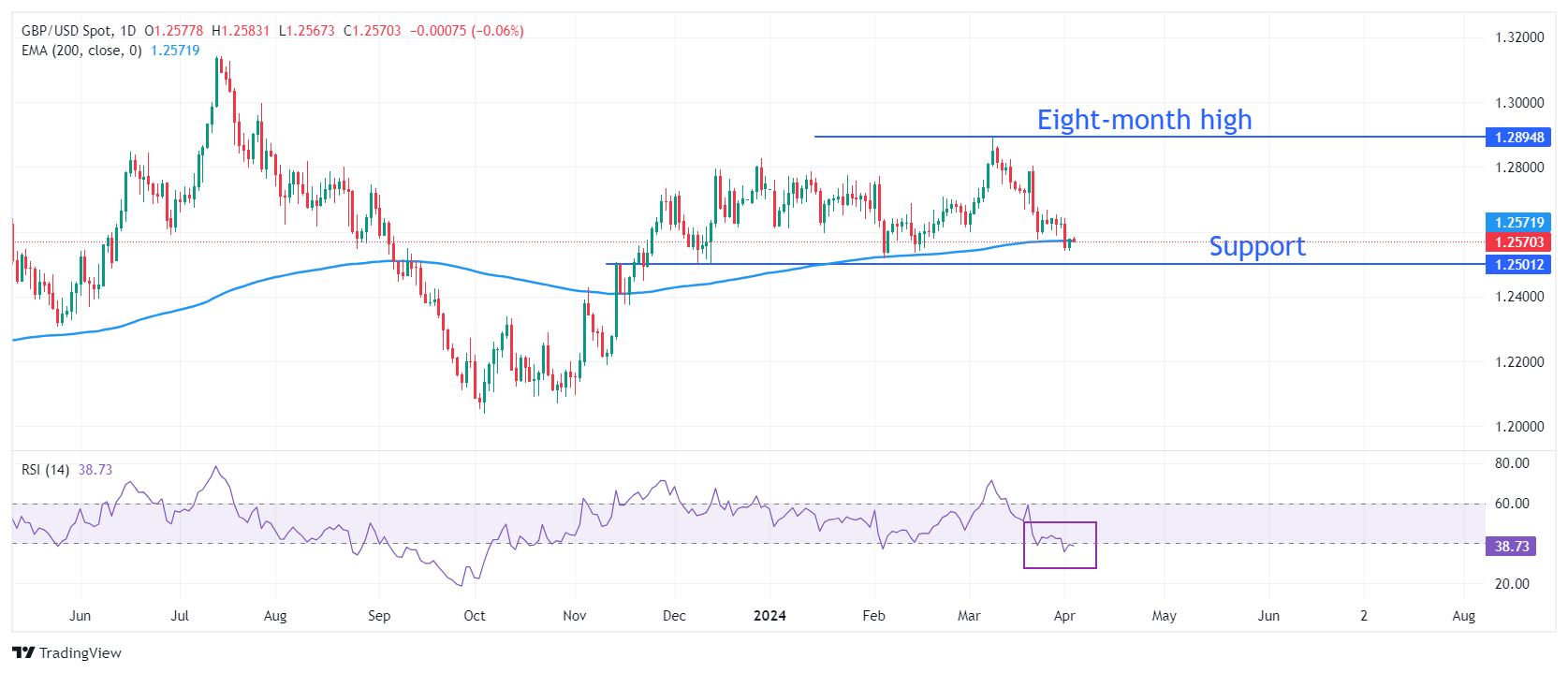- The Pound is facing pressure above 1.2580 due to cautious sentiment.
- The British manufacturing PMI signaled expansion in March for the first time in two years.
- Investors believe that the BoE will begin the rate reduction cycle in June.
The British Pound (GBP) struggles to extend its recovery above 1.2580 in the London session on Wednesday. Market participants' caution ahead of the March US Non-Farm Payrolls (NFP) data has offset the positive impact of the return to growth in the UK manufacturing PMI.
The UK manufacturing PMI rose surprisingly in March after 20 months of contraction, driven by upbeat domestic demand for consumer goods. S&P Global/CIPS reported that business optimism rose to its highest level since April 2023, with 58% of manufacturers expecting their production level to increase in the next 12 months. The agency added: “The improved sentiment reflected signs of stronger demand, new product launches, an improved trading environment, export opportunities and hopes that the cost and supply situation is approaching normal conditions.”
This week, the GBP/USD pair will be influenced by US labor market data and market expectations about when the Bank of England (BoE) will start reducing interest rates. Currently, investor expectations for rate cuts have been brought forward to the June policy meeting, up from the previous forecast in August, after British inflation softened more than expected in February.
Daily summary of market movements: Pound follows US dollar
- The British Pound moves slightly below 1.2600 against the US Dollar (USD) pending key developments. Investors are focused on Federal Reserve Chairman Jerome Powell's speech, expected at 16:10 GMT, and US NFP data, due to be released on Friday.
- Fed Chair Jerome Powell's speech could provide more clues about when the central bank will begin cutting interest rates. Investors currently expect the Fed to begin reducing borrowing costs as early as the June meeting.
- On the other hand, the US ADP employment data for March has provided some support to the US Dollar. The US ADP showed that private employers hired 184,000 workers, above expectations of 148,000 and the February reading of 155,000, which were revised up from 140,000. The US Dollar Index (DXY) finds support near 104.70 after correcting from four-month highs to slightly above 105.00.
- On Tuesday, the upbeat S&P Global/CIPS Manufacturing PMI for March provided support for the British Pound's rebound. The agency reported that the manufacturing PMI returned to expansion after 20 consecutive months of contraction. The manufacturing PMI rose to 50.3, above the 50.0 threshold, beating expectations and the previous reading of 49.9.
- Apart from the strong recovery in the manufacturing PMI, British house prices rose 1.6% in March, the highest pace since December 2022. Activity in the property sector has picked up despite the Bank of England maintaining interest rates at higher levels.
- The strong recovery in the manufacturing and real estate sectors suggests that the recession in the second half of 2023 was probably shallow and that the economy has returned to growth. In such a case, the BoE could achieve a so-called “soft landing”, a situation in which an economy manages to control inflation without triggering a recession.
- Looking ahead, investors will focus on the final S&P Global/CIPS Services PMI data for March, due out on Thursday. The services PMI is expected to remain unchanged from its preliminary reading of 53.4.
Technical Analysis: Pound Sterling Struggles to Extend Recovery Above 1.2580

The British Pound faces selling pressure as it tests the breakout of last week's consolidation formed in a range between 1.2575 and 1.2668. Cable is struggling to stay above the 200-day EMA, which is trading around 1.2570.
On a longer time frame, horizontal support from the December 8 low at 1.2500 would provide further cushion to the British Pound. Meanwhile, rallies are expected to remain limited near an eight-month high around 1.2900.
The 14-period Relative Strength Index (RSI) falls below 40.00 points. If it remains below this level, bearish momentum will be activated.
Employment FAQs
How do employment levels affect currencies?
Labor market conditions are a key element in assessing the health of an economy and, therefore, a key factor in the valuation of currencies. A high level of employment, or a low level of unemployment, has positive implications for consumer spending and therefore economic growth, boosting the value of the local currency. On the other hand, a very tight labor market – a situation in which there is a shortage of workers to fill vacant positions – can also have implications on inflation levels and, therefore, on monetary policy, since a supply of labor Low labor and high demand lead to higher wages.
Why is wage growth important?
The pace at which wages grow in an economy is key for policymakers. High wage growth means that households have more money to spend, which often translates into higher prices for consumer goods. Unlike more volatile sources of inflation, such as energy prices, wage growth is considered a key component of underlying and persistent inflation, as wage increases are unlikely to be undone. Central banks around the world pay close attention to wage growth data when deciding their monetary policy.
How much do central banks care about jobs?
The weight that each central bank assigns to labor market conditions depends on its objectives. Some central banks have mandates explicitly related to the labor market beyond controlling inflation levels. The United States Federal Reserve (Fed), for example, has the dual mandate of promoting maximum employment and stable prices. Meanwhile, the only mandate of the European Central Bank (ECB) is to keep inflation under control. Even so, and despite the mandates they have, labor market conditions are an important factor for the authorities given their importance as an indicator of the health of the economy and their direct relationship with inflation.
Source: Fx Street
I am Joshua Winder, a senior-level journalist and editor at World Stock Market. I specialize in covering news related to the stock market and economic trends. With more than 8 years of experience in this field, I have become an expert in financial reporting.







